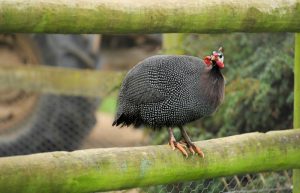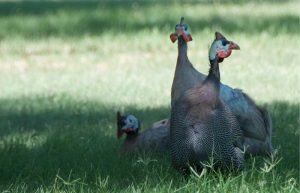
Can Guinea Fowl Fly?
Guinea fowl are a unique avian species originally from Africa. With their exotic appearance and usefulness for pest control, they can make a great addition to your homestead. But they are not just cool-looking chickens. There are some quirks you need to be aware of before adding guineas to your farm.
Can guinea fowl fly? Yes, guinea fowl can fly very well. They are known to be able to fly a distance between 400-500 feet at a time. Still considered an undomesticated poultry, guineas are just as good at walking long distances as they are at flying, so they can be quite a flight risk. Getting them to come back home can be nearly impossible, but there are many simple ways to encourage your guineas to stay safely at home.
While confining Guinea Fowl with covered fences or clipping their wings are options, there are other alternatives that will help them want to stay home rather than just force them to stay. Helping them want to stay home will keep both you and your birds happier in the long run.
When Do Guinea Fowl Start Flying?
By two weeks of age, most guinea keets have grown in the majority of their flight feathers. With their flight feathers present, they will be able to get enough air to escape the brooder and experiment with roosting in trees, on shelves, and anywhere else they can flap to.
Because of this, it is best to temporarily move them to a safe, covered pen before they start escaping and exploring too far at such a young age when they are more vulnerable to the elements and predators.
How to Prevent Guinea Fowl from Flying Away Forever
Guineas are naturally curious creatures, and they seem to not have lost as much of their wild tendencies as chickens have during the domestication process. Fortunately, there are things they love even more than freedom that you can leverage to keep them safely near home.
Meet The Guinea Fowl’s Social Needs
Guinea fowl love a crowd. They are naturally flock animals and they feel more comfortable in a crowd than on their own.(To learn how many guineas you should get, check out my article How Many Guinea Fowl to Get: What You Should Know.) You can use this to your advantage in each of the following ways:
- Adoption of keets by adults
- Influence of more docile species on keets
- Social manipulation of adults
Adoption of Keets by Adults
If you already have an established flock and wish to introduce new members, take care in how you go about it. Guinea fowl can be territorial towards newcomers. To introduce new birds to an established flock, it is best to choose keets rather than adults. You may be concerned that the bigger birds will bully the small newbies, but guineas actually become very protective of hatchlings once they’ve gotten used to them.
Try penning the keets up in a location where the established adults can hear them and interact with them from the other side of the fence. Before long, the adults will start screaming at you for getting too close to their little ones when all you’re trying to do is feed them. This method of introduction will allow the new guineas to become accepted members of the flock who would rather hang out with everyone else than risk getting lost alone.
Influence of More Docile Species on Keets
Guinea keets are highly impressionable. They have instincts, but nurture can win out over nature. Many guinea fowl keepers have found that when raised in the company of chickens, their guinea keets would end up a bit more docile and content at staying close to home than guineas raised only among their own kind.
Chickens also tend to be better parents than guineas, and the devoted care of a mother hen can actually produce a tendency in the keets to remain close to that chicken even after reaching adulthood. Since chickens are typically very happy staying close to home, guineas raised with hens are more likely to follow suit than to give in to their wilder side.
Social Manipulation of Adults
 When introducing adult guineas to your farm for the first time, don’t let them go free-range right away. They have no attachment to your property yet, and will be anxious to explore and find safe roosting ground…and they won’t have a reason to return.
When introducing adult guineas to your farm for the first time, don’t let them go free-range right away. They have no attachment to your property yet, and will be anxious to explore and find safe roosting ground…and they won’t have a reason to return.
Instead, keep guinea fowl housed together in a pen for several days after bringing them home. Keep them in a place where they can see and smell their future environment. This will keep them safe and contained while also allowing them to develop familiarity with their new surroundings.
Once they’ve all had several days to get familiar with the sounds and smells and views of their future home, release one lone guinea from the pen and let it run free. Their social preferences will cause the lone guinea to remain near the flock, even though he could fly free.
After the free guinea has chosen to remain at home with his flock for a few days in a row, release one more. If a few days pass and they both stay nearby, you can be pretty confident that none of them plan to leave. You’ve set the status quo for them and they tend to be happy to keep it up.
Meet The Guinea Fowl’s Habitat Needs
While guinea fowl love familiarity, they do have certain habitat needs that they will risk leaving a familiar environment in order to fill. If you take care to provide your guinea flock with all of their environmental needs, they will have no reason to leave in search of better accommodations.
- Temperature and moisture
- Varying diet
- Adequate space
Temperature and Moisture
Guinea fowl originated from the hot, dry continent of Africa. While they can survive in the winter and even manage with a little snow, keep their warm origins in mind. Guinea fowl are more susceptible to soaking wet conditions than becoming too cold in the snow. Keets especially should be kept warm and dry and even prevented from walking through dewy grass, as their feathers aren’t waterproof yet and will not be able to protect them from becoming too moist.
If your guineas find themselves in an environment that is familiar but has grown too cold or wet, they may decide to vacate the premises in search of more hospitable lodgings. To prevent this, be sure that even free-roaming guineas have access to a warm, dry shelter. Be sure that it will stay dry even in high wind and rain conditions.
Varying Diet
Guineas enjoy eating a wide variety of foods, from weeds and seeds to slugs and worms and even small rodents. Because of how their digestive systems work, they also require grit in their diet to help break down the other things they eat. Additionally, they can benefit from foraging for scratch feed left on the ground.
If, due to a flock population explosion, limited quarters, or some other circumstance, their food sources become depleted, guineas will be forced to expand their foraging grounds in order to fill their bellies. The more space you can give your guineas to forage, the better.
To help keep them content, take note of when their naturally available food sources, such as weeds and bugs, grow scarce as the seasons change. Provide them with more scratch feed during sparser months, and they will have no reason to search for food elsewhere.
If you want a complete overview on how to care for Guinea Fowl, visit my article How to Care For Guinea Fowl: Ultimate Guide For Beginners.
Adequate Space
For each member of your guinea flock, you should provide 2-3 square feet of space. While guineas are social creatures who prefer being in a flock, they do not like to be overcrowded. Overcrowded birds are more likely to fight amongst themselves and eventually some will leave to start their own flock in a less crowded space.
If you give your guineas plenty of room, they will be happier to remain in the space you provide for them.
Meet The Guinea Fowl’s Safety Needs
Like all living creatures, guinea fowl have an innate need to feel safe. Not only from the elements, but also from predators. Their primary method of achieving safety is roosting high off the ground.
If guineas don’t have comfortable roosting opportunities in the environment you provide, they are more likely to go out in search of them. But if you can provide them with elevated roosting options, they will be delighted to take advantage of them.
Most Guinea Fowl will prefer to roost outside in trees; however, this isn’t always the safest option. A smarter Guinea Fowl would decide to roost in the rafters of a barn or in a shed. You can also have your Guinea Fowl to return to a coop at night, although you will have to teach them to do this, as it is not in their nature.
To learn more about having a coop for your Guinea Fowl, check out my article Do Guinea Fowl Need a Coop? Essential Care Guide.
